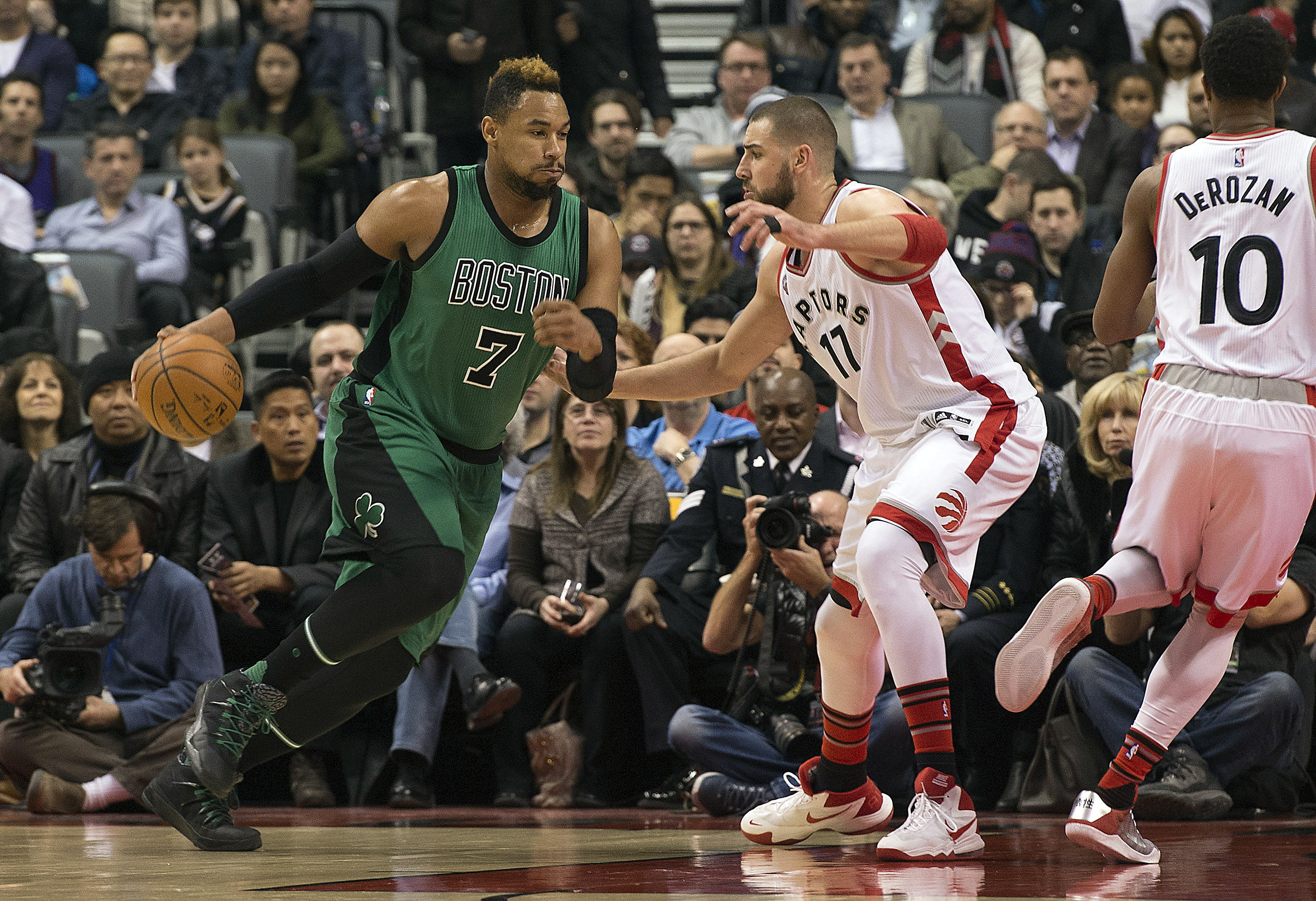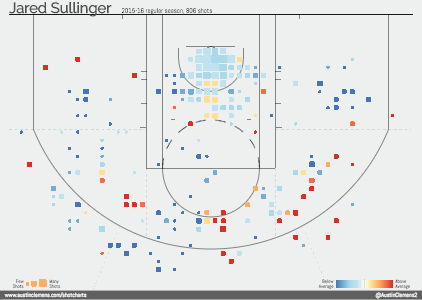Jared Sullinger just changed his avatar to the Toronto Raptors logo and tweeted the following:
WE THE NORTH #0
— Jared Sullinger (@Jared_Sully0) July 11, 2016
Shortly after, Adrian Wojnarowski of The Vertical reported that Sullinger has agreed to a one-year deal with the Raptors.
Sullinger became a popular name with Raptors fans once the Boston Celtics rescinded their qualifying offer to him, making him an unrestricted free agent. General manager Masai Ujiri swept in with a meeting on Sunday, moving quickly to get a deal done. Marc Stein reports that the deal is in the $6-million range, which likely means $5.6 million.
Unless they move a player, the Raptors can only offer the $5.63-million mid-level exception at most. They could also renounce their rights to Luis Scola, Jason Thompson, and Nando De Colo to sign Sullinger with an estimated $5.1 million in cap space, but the MLE route probably makes more sense from an asset-management standpoint, and because Sullinger can get an extra half-million that way. If that’s the way they go, they’ll have the $2.2-million bi-annual exception left to use for their 15th roster spot, plus any additional minimum contracts (like partially-guaranteed training camp invites).
(Update: The Woz is told they’re using the MLE.)
If that potential price tag looks low, it should. Given how the market has played out, the 24-year-old seemed a safe bet to command far beyond the mid-level once he became an unrestricted free agent. Lesser and comparable players have been earning in the $8-11 million range, and if the Raptors landed Sullinger on a cheap one-year deal, that’s a bargain.
It’s also why Ujiri slow-played the offseason, waiting for the market to settle some before striking. We preached patience, and Sullinger isn’t exactly a home run or anything, but waiting for prices to settle and teams to decide on their RFAs, like Boston, opened up some market opportunities. This is similar to last offseason, when the Raptors landed Bismack Biyombo on a one-year, make-good deal on July 15 after most of the market activity had slowed down. With limited financial resources and a desire to keep trade avenues open as long as possible, it made sense for Ujiri to take this approach, as we tried to explain. (And similar to Biyombo, by signing him to a discounted one-year deal to help him increase his market value, the Raptors will only have non-Bird Rights on him next summer, making him difficult to re-sign if the contract works out. Let’s worry about that next summer, though.)
Now, to be clear, Sullinger is a bit of an awkward fit at both ends of the floor. When asked about him in the last week – it happened a lot – my response was generally that he isn’t a square peg for a square hole, but the talent is such that if he’d sign in that price range, you just get the player and figure the fit out after the fact.
Sullinger spent about two-thirds of his time at power forward last season, per estimates from Nylon Calculus, and the rest of the time as a smaller five. It’s possible he’ll see time as a small-ball five for the Raptors, too, but he’s primarily being brought in to help Patrick Patterson at the four. Who starts doesn’t really matter and can be figured out later – Patterson is a starting-caliber four the team seems to like off the bench, and Sullinger started 73 games for a quality Celtics team – but Sullinger gives the Raptors some nice lineup mixing options, particularly at the offensive end.
While he’s heralded some as a floor-spacing big, Sullinger hasn’t exactly lit the world on fire from outside. In each of the last three years, he’s taken at least 1.9 threes per-36 minutes, and he’s yet to crack 30 percent. He’s a 27.6-percent 3-point shooter over 258 career games. He is not the en-vogue “stretch four” some were hoping for, but he is a capable shooter who can provide some element of spacing in the mid-range and from the corners – he shot just shy of 40 percent from 16 feet out to the 3-point line last year, and Boston very rarely asked him to shoot from the corners, where most players shoot a higher percentage. If the Raptors can turn Luis Scola into a 3-point threat by having him fade to the corner after setting screens, they’ll surely try to do so with Sullinger. In other words, he may not be a “stretch” option now, but the Raptors likely look at his jump shot and history of being passable from the mid-range out and see a player they can work with to turn into an offensive weapon in that regard.
Elsewhere on offense, Sullinger can help. One thing he provides that the team doesn’t have elsewhere in the frontcourt is with passing. He’s a very heady player and a willing distributor, and if he plays with the second unit, the Raptors may run some action through him in the high post. That also makes him a tougher cover on the dive or in the pick-and-pop, and he should add to the Raptors’ desired element of ball moving that they started to develop last year. A forward combination of Sullinger and DeMarre Carroll has some nice attack-the-close, make-the-next-pass potential (Patterson improved in this regard, too, for what it’s worth), and Sullinger should provide some help on the offensive glass if the Raptors opt to be a little more aggressive sending a second chaser this season (they eased back on that a lot as last year wore on to help their transition defense).
He’s also capable of bullying his way to the rim, either from a face-up situation or on the block. Over the last three seasons, he’s averaged 12.1 points, 8. 1 rebounds, and 2.1 assists, with a below-average true-shooting percentage but an above-average player efficiency rating and Offensive Real Plus-Minus. He’s a starting-caliber offensive player, and the Raptors just got him at a discount relative to the market. That alone is cause for optimism.
Defensively, Sullinger’s a bit of a conundrum. He’s a solid man-to-man defender, especially on the block, and his advanced defensive metrics were terrific last year. But he struggles in the pick-and-roll and isn’t particularly mobile, and his numbers were likely inflated by playing in a Celtics system that helped mask those shortcomings. He also played the bulk of his minutes next to Amir Johnson, and Jonas Valanciunas, while improved, is not Amir Johnson when it comes to helping teammates cover up for mistakes.
The Raptors just won 56 games with Scola starting alongside Valanciunas, so they’re surely confident they can make a Sullinger-Valanciunas pairing work. Sullinger is a better overall defender than Scola, but he still grades out a bit below average. Again, some advanced metrics will disagree with that, but individual defense is tough to put a number on. Defensive Real Plus-Minus loved him, and he ranked 11th among all centers in total RPM, even though opponents shot a robust 57.6 percent at the rim with him defending there, the highest percentage for a big on either the Raptors or the Celtics. He’s going to have some trouble alongside a more traditional center, too, as he won’t be able to switch on to the less mobile opposing big. He’s probably going to end up giving back some of what he provides on the offensive end at the defensive end, which you just have to accept and try to minimize.
How, exactly, you feel about Sullinger as a player and a fit will likely vary. On talent alone, this is a player who was one of the top producers in college basketball, became a first-round pick, and has contributed in a meaningful role for four seasons now. He’s still just 24, and there are clear ways the Raptors can try to get even more out of him than Boston got, at least offensively. The franchise has also shown an ability to help young players improve pretty rapidly, and they’ll likely get to work in short order on Sullinger’s functional conditioning (long considered a weakness) to insure he’s ready to hit the ground running in September.
This is a good move. Sullinger should be getting paid more than $5.6 million in this market, and he’s bet on Ujiri and the Raptors’ situation – a winning team with a recent history of getting the most out of players and improving their value – to help re-establish his standing around the league ahead of another cap spike in 2017. He’s not a perfect fit, but he’s more talented than his price tag would suggest, a fringe-starter who the Raptors can try to put alongside Valanciunas or use to help prop-up the second-unit offense. Whether you prefer if Sullinger starts or comes off the bench – the Raptors probably won’t figure this out themselves until the preseason – this is a win.
Patience pays off, sometimes.





